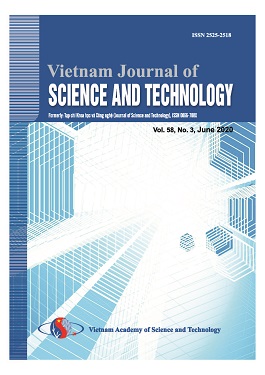Antioxidant potential of five compounds extract from the marine fungus Aspergillus flocculosus by DFR method: HAT and SET mechanism.
Author affiliations
DOI:
https://doi.org/10.15625/2525-2518/57/1/12903Keywords:
Aspergillus flocculosus, antioxidant, DFT, HAT, SETAbstract
Antioxidant potential of five compounds include ochraceopone F (1), aspertetranone D (2), cycloechinulin (3), wasabidienone E (4) and mactanamide (5) in the extracts from marine fungus Aspergillus flocculosus in Nha Trang was investigated by computational chemistry methods. All calculations were performed at the theoretical level M05-2X/6-311++G(d, p)//M05-2X/6-31+G(d) in the gas phase. The physicochemical properties such as bond dissociation energies (BDE), ionization energies (IE), electron affinity (EA) characterizing HAT (Hydrogen atom transfer) and SET (Single electronic transfer) antioxidant mechanisms were calculated.
As a result, the H-atom donating ability of the studies compounds increases in the descending order of BDE value (1) > (2) > (3) > (4) » (5). Wherein the compounds (4) and (5) represent as the most potential antioxidant with the lowest BDE in the gas phase being 74.9 and 75.1 kcal/ mol. Moreover, the electronic donating ability of the compounds increases as function of the descending order of IE value (2) > (1) > (5) > (3) > (4). And the electron accepting abitlity decreases in decreasing EA value (4) > (3) > (2) > (5) > (1). Compound (4) (wasabidienone E) has the smallest IE value of 6.56 eV and has the largest EA value of 2.33 eV.Downloads
References
Konig G.M., Kehraus S., Seibert S.F., Abdel-Lateff A., Muller D., Natural products from marine organisms and their associated microbes, Chembiochem 7 (2006) 229–238.
Aly A.H., Debbab A., Kjer J., Proksch P., Fungal endophytes from higher plants: A prolific source of phytochemicals and other bioactive natural products, Fungal Divers 41 (2010) 1–16.
Wang Y., Qi S., Zhan Y., Zhang N., Wu A.A., Gui F., Guo K., Yang Y., Cao S., Hu Z., et al, Aspertetranones A-D, Putative Meroterpenoids from the Marine Algal-Associated Fungus Aspergillus sp. ZL0-1b14, J. Nat. Prod 78 (2015) 2405–2410.
Ishikawa K., Hosoe T., Itabashi T., Wakana D., Takizawa K., Yaguchi T., Kawai K., I. Novoamauromine and Cycloechinulin: Two New Diketopiperazine Derivatives from Aspergillus novofumigatus, Chem. Pharm. Bull 58 (2010) 717–719.
Elbandy M., Shinde P.B., Hong J.-K., Bae K.-S., Kim M., Lee S.-M., Jung J.H., α-Pyrones and yellow pigments from the sponge-derived fungus Paecilomyces lilacinus. Bull, Korean Chem. Soc 30 (2009) 188–192.
Lorenz P., Jensen P.R., Fenical W., Mactanamide, A New Fungistatic DiketopiperazineAspergillus sp, Nat. Prod. Lett 12 (1998) 55–60.
Galano A., Free Radicals Induced Oxidative Stress at a Molecular Level: The Current Status, Challenges and Perspectives of Computational Chemistry Based Protocols, Journal of the Mexican Chemical Society (2015) 231-262.
Leopoldini M., Russo N., Toscano M., The Molecular Basis of Working Mechanism of Natural Polyphenolic Antioxidants, Food Chemistry 125 (2011) 288-306.
Thong N. M., Duong T., Pham L. T., Nam P. C., Theoretical Investigation on the Bond Dissociation Enthalpies of Phenolic Compounds Extracted from Artocarpus Altilis Using ONIOM(ROB3LYP/6-311++G(2df,2p):PM6) Method, Chemistry Physical Letters 613 (2014) 139-145.
Thong N. M., Quang D. T., Bui N. H. T., Dao D. Q., Nam P. C., Antioxidant Properties of Xanthones Extracted from the Pericarp of Garcinia Mangostana (Mangosteen): A Theoretical Study, Chemistry Physical Letters 625 (2015) 30-35.
Thomas Bottyan - Electrostatic Potential maps. Available from: <https://chem.libretexts.org/>, date visited 1st July, 2018.
Galano A., Mazzone G., Marino T., Alvarez-Idaboy J. R., Russo N., Alvarez-Diduk R., Food Antioxidants: Chemical Insights at the Molecular Level, Annual Review of Food Science and Technology 7 (2016) 335-352.
Downloads
Published
How to Cite
Issue
Section
License

This work is licensed under a Creative Commons Attribution-ShareAlike 4.0 International License.
Vietnam Journal of Sciences and Technology (VJST) is an open access and peer-reviewed journal. All academic publications could be made free to read and downloaded for everyone. In addition, articles are published under term of the Creative Commons Attribution-ShareAlike 4.0 International (CC BY-SA) Licence which permits use, distribution and reproduction in any medium, provided the original work is properly cited & ShareAlike terms followed.
Copyright on any research article published in VJST is retained by the respective author(s), without restrictions. Authors grant VAST Journals System a license to publish the article and identify itself as the original publisher. Upon author(s) by giving permission to VJST either via VJST journal portal or other channel to publish their research work in VJST agrees to all the terms and conditions of https://creativecommons.org/licenses/by-sa/4.0/ License and terms & condition set by VJST.
Authors have the responsibility of to secure all necessary copyright permissions for the use of 3rd-party materials in their manuscript.







 Vietnam Journal of Science and Technology (VJST) is pleased to notice:
Vietnam Journal of Science and Technology (VJST) is pleased to notice: